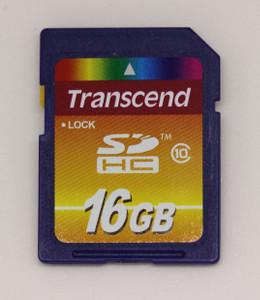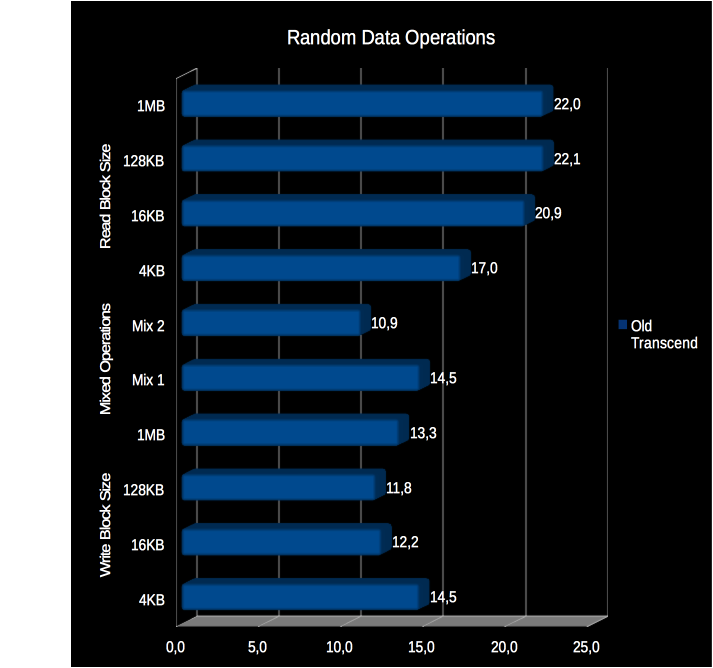An old Transcend SDCard
| Manufacturer | Transcend |
| Brand | SDHC Class 10 |
| Announced Capacity | 16 GB |
| Formatted Capacity | 15,02 GiB |
| UHS Class | N/A |
| SD Bus | SD High Speed (SDR25) |
| Price | £7.50 Amazon.co.uk $7.50 Amazon.com €5,12 AliExpress |
In order to be able to compare the current breed of SD Cards, or even MicroSD, we need to find a baseline, from which to compare a draw conclusions. If at the same time, we can also get an idea of historical evolution, the better. Although not taking into account price declines solely due to Moore’s law, performer is expected to show significant improvements, as new SDA specifications got available, push top performance to more than 300MiB/s.
Going through the storage bin, an easy victim was found, which had all the right characteristics: proven reliability, stable and reproducible performance. Let’s then present our Baseline
SD Card: an old Transcend SDHC Card. It’s know 5 years old and heavily used as main storage for a Canon Camera, which generated 20+ MiB files, so you can imagine how many cycles those flash cells have already been endured. Based on SLC flash, it’s really an old breed of SD cards, as SLC flash is not commonly used today even for professional SSD, not to mention SD Cards, where it’s nowhere to be seen, regardless on how high end the flash card is…
This char acteristic the the reason behind high reliability and hopefully decent writing speeds, although due to old age overall reading speeds won’t be worth writing home about, as you need to remember: this SD card, although SDHC, predates the new UHS bus, and this is limited to 25MiB/s bandwidth, either in reading or writing operations. It is in fact a significant step forward from the
acteristic the the reason behind high reliability and hopefully decent writing speeds, although due to old age overall reading speeds won’t be worth writing home about, as you need to remember: this SD card, although SDHC, predates the new UHS bus, and this is limited to 25MiB/s bandwidth, either in reading or writing operations. It is in fact a significant step forward from the
baseline SD specification, as capacity was then able to exceed 2 GiB, but bus speed also doubled to 12,5MiB/s to the high speed bus of 25 MiB/s. This may be slow as compared with current SDA specifications, which can achieve 104 MiB/s on the same physical interface, or even 312 MiB/s on the new interface which uses twice the number of electrical traces, thus breaking some compatibility.
However, as history taught us time and again, actual real performance if often quite different from the theoretical bus performance. This is even more truth we discussing flash memory, which is mostly write speed limited.
As compared ties the past, this specific model of SD card is still available on most markets (see here and here), and prices have obviously dropped over the years, but it is still in the same price range and the competition. Not that it makes sense to purchase one right now, as better as faster SD Cards become available, but it allows for some apples to apples comparison.
How does it really performs? Let’s see.
Well, it behaves mostly as expected: read operations are limited to around 22MiB/s due to old SD bus, but other than that is actually quite stable. It does lowers performance with 4KB blocks but you won’t have nightmares because of it. On the other hand write operations are heavily depending on the data: compressible data achieves more than 20 MiB/s (again, except for 4KB blocks), but incompressible data write averages 12,5 MiB/s but never gets lower than 11 MiB/s and in doing so, complies fully with Class10 requirements. Finally, mixed operations are slower than expected, but again never gets lower the 10MiB/s mark.
[showad block=2]Overall, this was quite a high performance SD card for its time, read operations are limited by the bus speed, and write operations do fully comply with Class10 requirements. How do modern SD cards compare? We’ll see…



